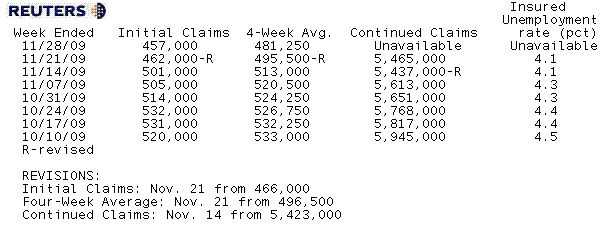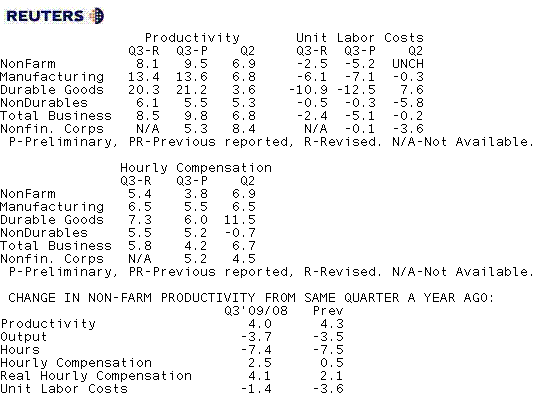Blog

Jobless Claims Improve. Labor Force Productivity Implications on Future Hiring
The US Labor Department released their report on initial jobless benefit claims this morning.
Jobless claims fell to 457,000 in the week ending Nov. 28 week. This is 5,000 less than the previous week and much better than consensus estimates of 480,000. Last week's jobless claims data was revised for the better, from 466,000 to 462,000.
This was the smallest amount of new jobless claims since September 6, 2008 when initial claims totaled 447,000.
The 4- week moving average for Jobless claims fell to 481,250 from the previous read of 495,500, which was revised lower from 496,500. This is the lowest 4-week average since November 1, 2009 when it was 480,250.
Continuing claims rose to 5.465 million in the week ending Nov. 21, less than the market was expecting but higher than last week's revised higher print of 5.437 million (from 5.423)
The insured unemployment rate was unchanged at 4.1 %.
Here is a table summarizing recent jobless claims data…

Below is a summary of reasons given for filing for unemployment benefits…notice what industries continue to be the major source of weakness in the labor market.
STATES WITH A DECREASE OF MORE THAN 1,000
MI -1,242: Fewer layoffs in the automobile industry.
STATES WITH AN INCREASE OF MORE THAN 1,000
CO +1,083:No comment.
MA +1,172:Layoffs in the construction industry.
TN +1,194:Layoffs in the service and manufacturing industries.
GA +1,325:Layoffs in the construction and trade industries.
KS +1,330:No comment.
OH +1,491:Layoffs in the manufacturing industry.
NY +1,589:Layoffs in the construction and service industries.
SC +1,590:Layoffs in the manufacturing industry.
AL+1,610:Layoffs in the construction, service, and manufacturing industries.
VA +1,666:No comment.
WI +1,877:Layoffs in the trade, service, and manufacturing industries.
KY +1,882:Layoffs in the mining and manufacturing industries.
AR +1,965:Layoffs in the manufacturing industry.
FL +2,154:Layoffs in the construction, trade, and service industries, and agriculture.
TX +3,500:Layoffs in the trade, service, and manufacturing industries.
PA:+5,285:Layoffs in the transportation equipment industry.
NC +5,557:Layoffs in the construction, trade, transportation, lumber/wood, mining, and petroleum industries.
IL +6,168: Layoffs in the construction and manufacturing industries.
CA +14,796: Return to a five day workweek, as well as layoffs in the service industry.
CONSTRUCTION AND MANUFACTURING….
The Department of Labor also released final estimates of third quarter Labor Productivity and Costs.
Labor productivity is calculated by dividing an index of real output byrnan index of the combined hours worked of all persons, includingrnemployees, proprietors, and unpaid family workers. The more productivernan employee the more they produce. A productivernwork force is essential if the economy is to grow faster and faster. Itrnis even more important when firms are laying off employees…thernremaining work force is relied upon to perform additional tasks.
Nonfarm business sector labor productivity increased at an 8.1% annual rate during the third quarter of 2009.This was the largest gain in productivity since the third quarter of 2003, and reflects a 2.9% increase in output and a 4.8%decline in hours worked.
Manufacturing sector productivity grew 13.4% in the third quarter of 2009, as output rose 8.4% and hours worked fell 4.4%. The third quarter gain in manufacturing productivity was the largest in the series, which begins in the second quarter of 1987.
BLS defines unit labor costs as the ratio of hourly compensation tornlabor productivity; increases in hourly compensation tend to increasernunit labor costs and increases in output per hour tend to reduce them.rnLabor costs make up about 70% of business expenses so if a company isrnnot using their labor force effectively they could be wasting a lot ofrnmoney!!!
IMPORTANT: the cost of labor to produce a single unit of product. Laborrnis the biggest cost of production and these costs are usually passedrndown to consumers or companies pass along the losses to their P&L. rnWe need labor costs to decrease as productivity increases.
Unit labor costs in nonfarm businesses fell 2.5% in the third quarter of 2009, better than the the 5.2% decline rate which was first reported. This was a function of productivity growing at a faster rate than hourly compensation. Unit labor costs declined 1.4% over the last four quarters.
Here is a table of Productivity Data..

While the final estimate of Q3 Productivity was lower than initiallyrnthought, a productivity growth rate over 8.00% is still an extremely efficient labor force.
With that in mind, if productivity remains at these high levels and demand (output) does not increase , businesses will have less incentive to hire new labor. Given the uncertain economic outlook, we should expect to continue to see employers offering temporary job opportunities as seasonal influences warrant. From a positive perspective, the upward revision to unit labor costs and still extremely efficient read on productivity, while a function of less output, does support the notion that the pace of layoffsrnwill continue to slow.Furthermore, a more productive work force and still falling unit labor costs implies greater corporate profitablity. Perhaps the surge in productivity will lead to larger dividend payments to shareholders OR increased business investment spending….either way, consumer demand growth is a necessity if the overall economy is to stabilize and maintain a consistent growth rate.
If you are an unemployed American looking for work…re-tool and re-educate yourself.
All Content Copyright © 2003 – 2009 Brown House Media, Inc. All Rights Reserved.nReproduction in any form without permission of MortgageNewsDaily.com is prohibited.
Latest Articles
By John Gittelsohn August 24, 2020, 4:00 AM PDT Some of the largest real estate investors are walking away from Read More...
Late-Stage Delinquencies are SurgingAug 21 2020, 11:59AM Like the report from Black Knight earlier today, the second quarter National Delinquency Survey from the Read More...
Published by the Federal Reserve Bank of San FranciscoIt was recently published by the Federal Reserve Bank of San Francisco, which is about as official as you can Read More...

Comments
Leave a Comment